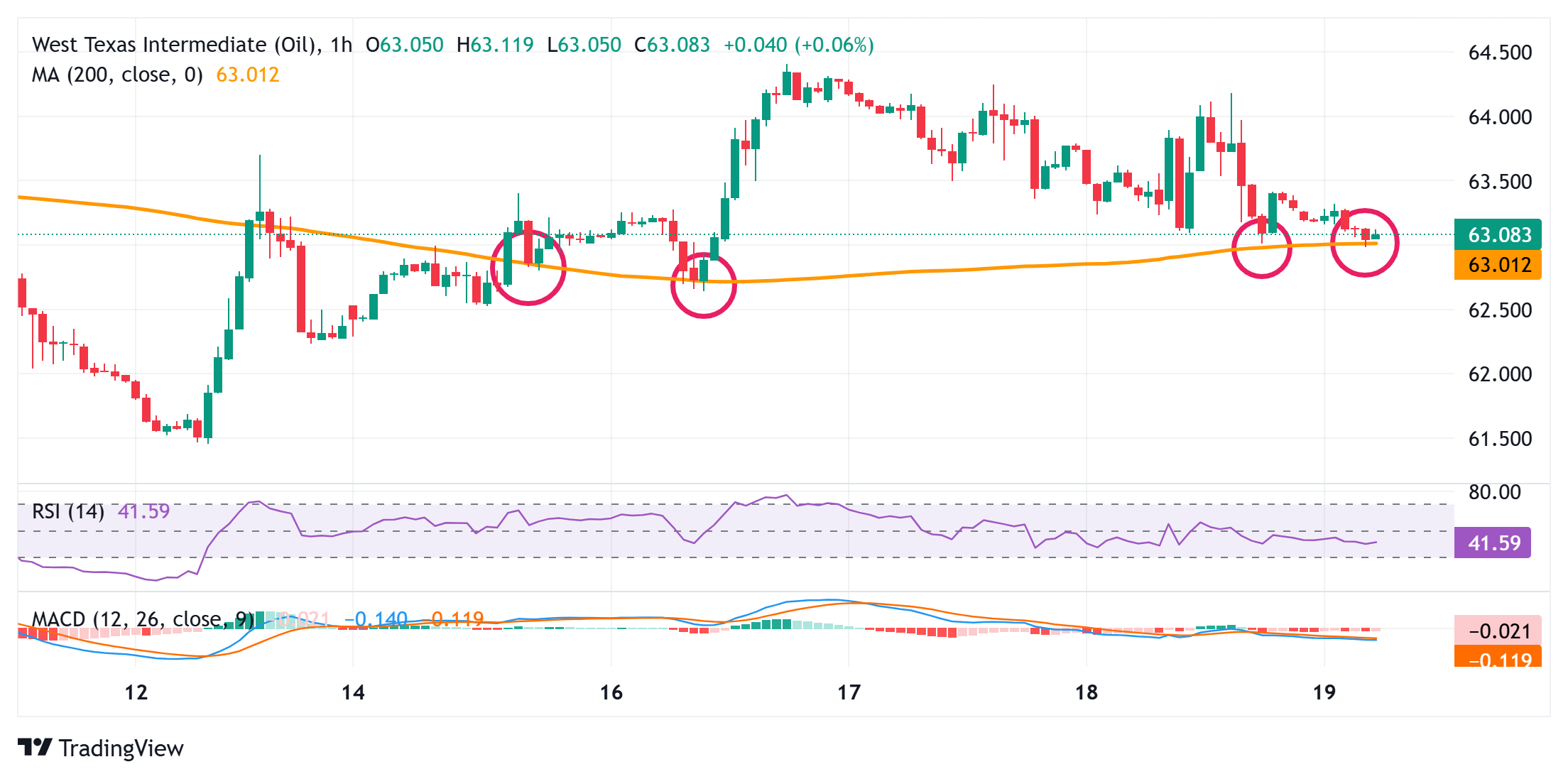WTI Price Forecast: Flirts with 100-hour SMA pivotal support near $63.00 mark
- WTI retains negative bias for the third straight day amid fuel demand and supply glut concerns.
- The post-FOMC USD recovery from a three-and-a-half-year low also weighs on the commodity.
- Bearish traders now await a convincing break below the 100-hour SMA before placing fresh bets.
West Texas Intermediate (WTI) US Crude Oil prices drift lower for the third consecutive day on Friday amid growing concerns over slowing US demand and a supply glut in the coming quarters. Adding to this, the recent strong US Dollar (USD) recovery from its lowest level since February 2022 puts pressure on the commodity and drags it to the $63.00 mark during the Asian session.
From a technical perspective, the black liquid is currently placed around the 100-hour Simple Moving Average (SMA) pivotal support. Given that oscillators on the said chart have been gaining negative traction and are still away from being in the oversold territory, a convincing break below the said support, or the $63.00 mark, will be seen as a fresh trigger for bearish traders and set the stage for deeper losses.
Crude Oil prices might then extend the downfall towards the $62.40-$62.30 intermediate support before eventually dropping to the $62.00 round-figure mark. Some follow-through selling would expose the 61.45 region, or the lowest level since June touched earlier this month.
On the flip side, any attempted recovery beyond the $63.30 immediate hurdle is more likely to attract some sellers and remain capped near the $63.75 horizontal resistance. This is closely followed by the $64.00 round figure, which, if cleared, could lift Crude Oil prices to the $64.40 region, or a nearly two-week high touched on Tuesday. The black liquid might then aim to reclaim the $65.00 psychological mark.
WTI 1-hour chart

WTI Oil FAQs
WTI Oil is a type of Crude Oil sold on international markets. The WTI stands for West Texas Intermediate, one of three major types including Brent and Dubai Crude. WTI is also referred to as “light” and “sweet” because of its relatively low gravity and sulfur content respectively. It is considered a high quality Oil that is easily refined. It is sourced in the United States and distributed via the Cushing hub, which is considered “The Pipeline Crossroads of the World”. It is a benchmark for the Oil market and WTI price is frequently quoted in the media.
Like all assets, supply and demand are the key drivers of WTI Oil price. As such, global growth can be a driver of increased demand and vice versa for weak global growth. Political instability, wars, and sanctions can disrupt supply and impact prices. The decisions of OPEC, a group of major Oil-producing countries, is another key driver of price. The value of the US Dollar influences the price of WTI Crude Oil, since Oil is predominantly traded in US Dollars, thus a weaker US Dollar can make Oil more affordable and vice versa.
The weekly Oil inventory reports published by the American Petroleum Institute (API) and the Energy Information Agency (EIA) impact the price of WTI Oil. Changes in inventories reflect fluctuating supply and demand. If the data shows a drop in inventories it can indicate increased demand, pushing up Oil price. Higher inventories can reflect increased supply, pushing down prices. API’s report is published every Tuesday and EIA’s the day after. Their results are usually similar, falling within 1% of each other 75% of the time. The EIA data is considered more reliable, since it is a government agency.
OPEC (Organization of the Petroleum Exporting Countries) is a group of 12 Oil-producing nations who collectively decide production quotas for member countries at twice-yearly meetings. Their decisions often impact WTI Oil prices. When OPEC decides to lower quotas, it can tighten supply, pushing up Oil prices. When OPEC increases production, it has the opposite effect. OPEC+ refers to an expanded group that includes ten extra non-OPEC members, the most notable of which is Russia.
